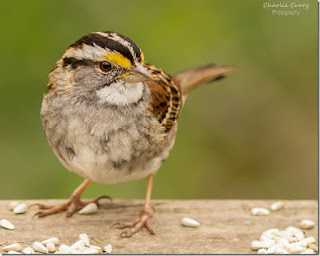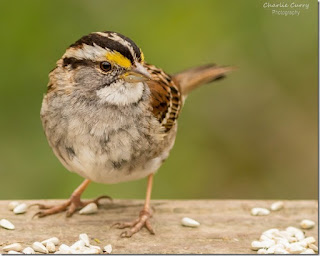Name That Winter Sparrow
Melissa Donahue - Naturalist
Photo by Charlie Curry
When hiking through a field in the winter have you noticed
small birds flitting around? Do you peer
through the brambles to try to figure out what the little brown bird might be? Often this little brown bird is a sparrow, and sparrows can be hard to identify.
Winter is the best time to see sparrows in Middle Tennessee. Often found in fields, along the forest edge
or sometimes at feeders, we can spot both year-round residents and migrants. Through close observation you will begin to
notice the differences in these little brown birds as they search for seeds.
https://www.allaboutbirds.org/guide/Field_Sparrow/sounds
Fox Sparrow – Photo by Graham Gerdeman
This large Fox Sparrow is a regular but uncommon winter resident. Seen at feeders as well as foraging in the leaf litter this sparrow is easily recognized by its reddish color. The sparrow is heavily steaked on the chest with a reddish tail. On warm winter days this bird sings from a camouflaged post, so you will hear the song before you see the bird.
https://www.allaboutbirds.org/guide/Fox_Sparrow/sounds
This White-crowned Sparrow, another winter visitor that may be seen on the ground below feeders, in grasslands, and in fields. This bird has an eye-catching crown
on the head with two broad black stripes separated by a broad white stripe. A sparrow with little streaking, it has two
white wing-bars and a dark brown tail. As spring arrives listen for this sweet
whistle.
https://www.allaboutbirds.org/guide/White-crowned_Sparrow/sounds
Want to learn to more about these sparrows and how to better
identify them? Sign up for the Identifying Winter Sparrows Workshop happening this Friday and Saturday! During
this workshop, BIRD Program Volunteer Graham Gerdeman, will teach you where to find and how to identify winter sparrows and other winter grassland birds. The workshop will focus on key characteristics, vocalizations, habitat, and
behavior that aid in identification. Beginning with a Friday-evening webinar
followed by a morning hike you will search the fields and edges of Warner Parks
for these often shy, but impressive birds.
email wpnc@nashville.gov or call
615-862-8555 to register.
Presenters: Graham Gerdeman and BIRD Program Staff











No comments:
Post a Comment